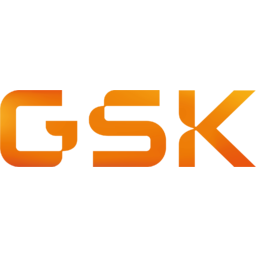
P/E ratio for GlaxoSmithKline (GSK)
P/E ratio as of April 2024 (TTM): 11.3
According to GlaxoSmithKline's latest financial reports and stock price the company's current price-to-earnings ratio (TTM) is 11.312. At the end of 2022 the company had a P/E ratio of 4.14.
P/E ratio history for GlaxoSmithKline from 2001 to 2023
PE ratio at the end of each year
| Year | P/E ratio | Change |
|---|---|---|
| 2022 | 4.14 | -71.88% |
| 2021 | 14.7 | 45.85% |
| 2020 | 10.1 | -35.71% |
| 2019 | 15.7 | -0.75% |
| 2018 | 15.8 | -55.39% |
| 2017 | 35.5 | -44.04% |
| 2016 | 63.4 | 919.49% |
| 2015 | 6.22 | -66.06% |
| 2014 | 18.3 | 54.42% |
| 2013 | 11.9 | 0.16% |
| 2012 | 11.9 | 7.42% |
| 2011 | 11.0 | -64.77% |
| 2010 | 31.3 | 219.92% |
| 2009 | 9.79 | 6.19% |
| 2008 | 9.22 | -12.84% |
| 2007 | 10.6 | -11.42% |
| 2006 | 11.9 | -12.62% |
| 2005 | 13.7 | -10.16% |
| 2004 | 15.2 | 1.29% |
| 2003 | 15.0 | -17.25% |
| 2002 | 18.1 | -42.66% |
| 2001 | 31.7 |
P/E ratio for similar companies or competitors
| Company | P/E ratio | P/E ratio differencediff. | Country |
|---|---|---|---|
 Novartis NVS | 24.9 | 120.01% | 🇨🇭 Switzerland |
 Pfizer PFE | 13.7 | 20.82% | 🇺🇸 USA |
 Sanofi SNY | 14.5 | 28.17% | 🇫🇷 France |
 Merck MRK | 68.8 | 508.39% | 🇺🇸 USA |
 AstraZeneca AZN | 34.5 | 205.20% | 🇬🇧 UK |
 Teva Pharmaceutical Industries TEVA | -6.59 | -158.26% | 🇮🇱 Israel |
 Dynavax Technologies
DVAX | 13.1 | 16.14% | 🇺🇸 USA |
How to read a P/E ratio?
The Price/Earnings ratio measures the relationship between a company's stock price and its earnings per share. A low but positive P/E ratio stands for a company that is generating high earnings compared to its current valuation and might be undervalued. A company with a high negative (near 0) P/E ratio stands for a company that is generating heavy losses compared to its current valuation.
Companies with a P/E ratio over 30 or a negative one are generaly seen as "growth stocks" meaning that investors typically expect the company to grow or to become profitable in the future.
Companies with a positive P/E ratio bellow 10 are generally seen as "value stocks" meaning that the company is already very profitable and unlikely to strong growth in the future.